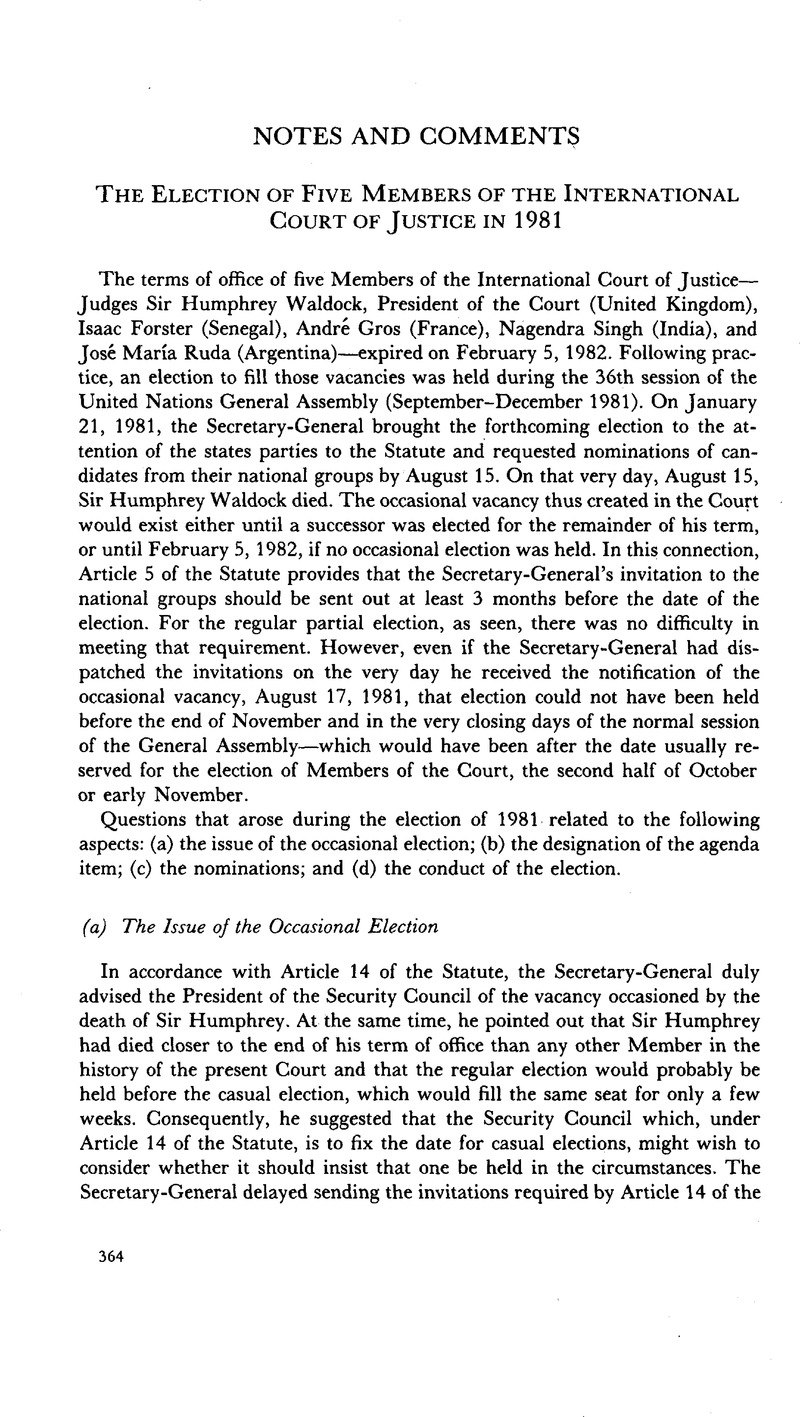No CrossRef data available.
Published online by Cambridge University Press: 27 February 2017

1 On the procedure for filling occasional vacancies, see our Note, The 1981 Occasional Elections to Fill Two Vacancies on the International Court of Justice, 75 AJIL 349 (1981).
2 UN Doc. A/36/451–S/14645 (Aug. 26, 1981).
3 For the provisional agenda, see UN Doc. A/36/50 (July 17, 1981), subsequently adopted as such, UN Doc. A/36/251 (Sept. 18, 1981). Item 15 was entitled “Elections to fill vacancies in principal organs” and subitems (a) and (b) referred respectively to the Security Council and ECOSOC.
4 Cf. the case of Judge Ammoun, elected to the Court on Nov. 16, 1965 to fill an occasional vacancy, who did not take part in the second decision in the South West Africa cases, the hearings having terminated during that November. ICJ Pleadings, 8 South West Africa cases 100 (1966).
5 Cf. Arts. 31 and 32, Vienna Convention on the Law of Treaties, UN Doc. A/CONF.39/27 (1969), reprinted in 63 AJIL 875 (1969), 8 ILM 679 (1969).
6 In addition to the Tunisia/Libya Continental Shelf case, other pending cases at the end of December included Application for Review of Judgement No. 273 of the United Nations Administrative Tribunal (advisory opinion) and the Delimitation of the Gulf of Maine case (Canada/United States of America).
7 UN Docs. S/14799 (Dec. 17, 1981); S/14806 (Dec. 21, 1981); S/PV.2321, at 2 (prov.) (Dec. 21, 1981); A/36/PV.105, at 73 (prov.) (Dec. 18, 1981).
8 UN Doc. A/34/251, item 15 (1979).
9 Rosenne, note 1 supra, at 357. Those two elections were designated as two sub-subitems of one subitem.
10 UN Doc. A/36/302-S/14502 (Sept. 14, 1981). For the curricula vitae of the candidates, see Doc. A/36/303-S/14503 and Corrs. 1 and 2 (Sept. 22, 1981).
11 UN Doc. A/36/302/Rev.1-S/14502/Rev.1 (Nov. 4, 1981). This revised list was issued at the specific request of the General Assembly at its 43d meeting on Nov. 2, 1981. UN Doc. A/36/PV.43, at 43 (prov.) (1981). Such reissue is not unprecedented, and it greatly facilitates the conduct of the elections.
12 See Institut Für Ausländisches Öffentliches Recht Und Völkerrecht, Statut et Règlement de la Cour Permanente de Justice Internationale: Eléments D’Interprétation31, 59 (ed. Schenk von Stauffenberg, 1934); M. Hudson, The Permanent Court of International Justice, 1920–1942, at 155 (1943).
13 Professor Jennings was nominated by the national group of the United Kingdom before the death of Sir Humphrey Waldock.
14 On this aspect, see our 1 The Law and Practice of the International Court 181 n.2 (1965).
15 From inquiries made by the present writer through colleagues who participated in the election in the Security Council.
16 UN Doc. S/PV.2321, at 3 and 4 (prov.) (1981).
17 UN Doc. S/PV.2306, at 36 (prov.) (1981).